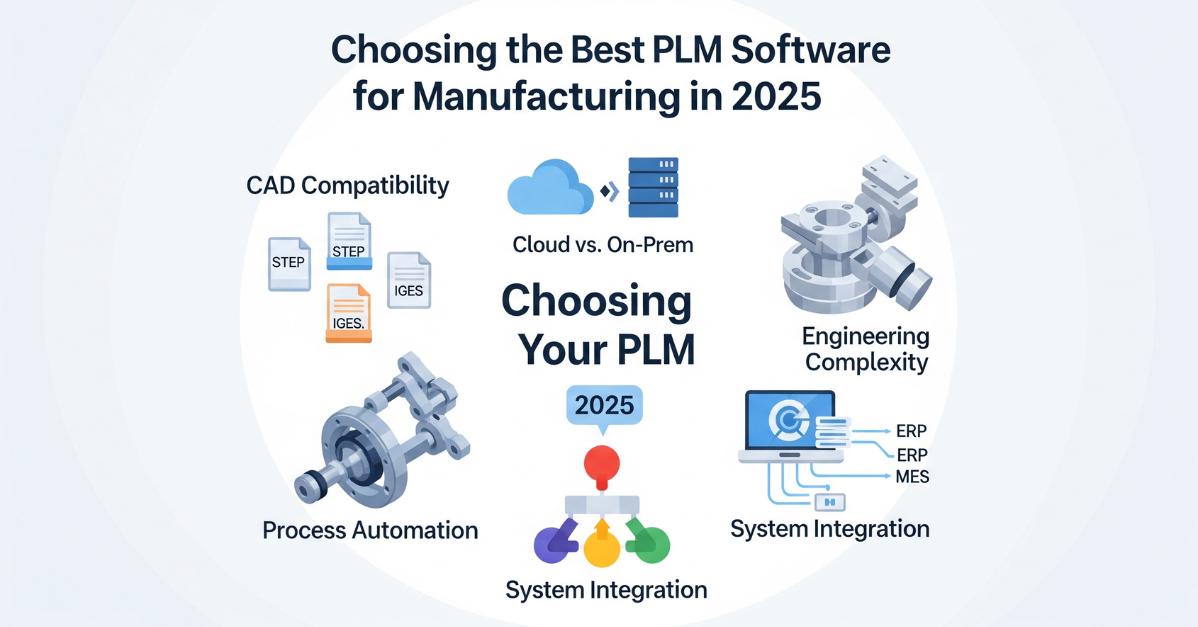Selecting the right PLM software is one of the most impactful decisions a product-driven organization can make. The system you choose will shape how your teams collaborate, manage change, and bring new products to market.
But with so many options—each with different strengths, licensing models, and integration capabilities—it’s easy to feel overwhelmed. Here’s how manufacturers can evaluate the best PLM software in 2025 based on real needs and long-term growth.
What to Look for in PLM Software
Before choosing a platform, get clear on what your business needs today—and where you’re heading. Consider:
- CAD compatibility – Do you use SOLIDWORKS, CATIA, Inventor, or multiple CAD tools?
- Cloud vs on-prem – Do you need cloud-based PLM for remote collaboration or prefer on-prem for compliance?
- Engineering complexity – Do you manage complex assemblies, configurations, or variants?
- Process automation – Are you looking to formalize workflows like Engineering Change Management (ECM) or New Product Introduction (NPI)?
- Integration – Does the system need to work with ERP, MES, CRM, or quality systems?
These questions will help you narrow your options to PLM tools that align with your technical, operational, and budgetary realities.
Top PLM Systems for Manufacturing Teams
There’s no one-size-fits-all answer. But here are some of the top platforms used by manufacturers in 2025:
- Dassault Systèmes 3DEXPERIENCE and ENOVIA – Deep CAD integration and scalable cloud-based collaboration
- Aras Innovator – Flexible, open architecture and strong customization capabilities
- Autodesk Vault and Fusion 360 Manage – Integrated PDM and cloud PLM tools for Autodesk-centric engineering environments
- PTC Windchill – Robust enterprise functionality with strong change management tools
- Siemens Teamcenter – Widely adopted in regulated, global manufacturing environments
Some platforms are easier to configure; others require more upfront customization but offer long-term flexibility. Your use case will help determine the best fit.
Why Implementation Is Just as Important as the Software
Even the best PLM platform can fall short if it’s poorly implemented. Many manufacturers invest in powerful tools—only to find that poor adoption, missing integrations, or overly rigid processes limit their value.
That’s where xLM Solutions comes in. We help companies not only choose the right PLM system, but also tailor it to how your teams actually work. Our implementation services cover everything from requirements analysis and proof-of-concept to configuration, training, and long-term support.
We’ve seen firsthand how rushed or one-size-fits-all implementations can stall progress. Our goal is to build a solution that your team will use, trust, and grow with.
Future-Proofing Your PLM Investment
In 2025, the best PLM software isn’t just functional—it’s flexible. It should support:
- Scalable cloud or hybrid deployment
- Open APIs for integration
- User-friendly interfaces to reduce training time
- Modular features to grow with your business
- Ongoing vendor support and a strong partner ecosystem
Whether you’re replacing legacy systems, centralizing global operations, or launching your first PLM initiative, choosing the right platform now will pay dividends for years to come.
Talk to an Expert Before You Decide
Looking for help comparing PLM options or planning your next step? The team at xLM Solutions has implemented and integrated systems across industries, platforms, and geographies.
We are happy to walk through your requirements and share what we’ve seen work in the real world. Get in touch with our team anytime.

